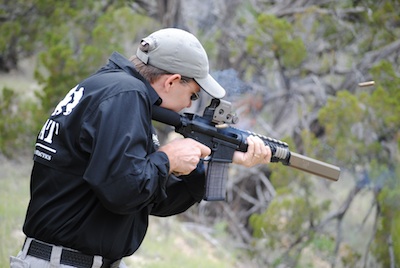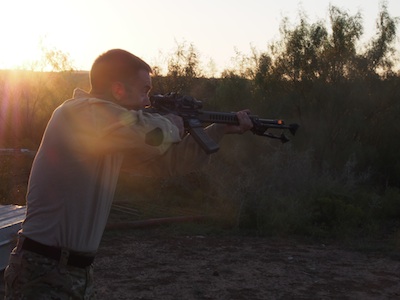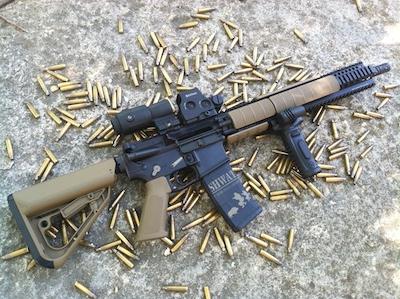As a friendly reminder for the hog hunting brotherhood, SHWAT™ stands for Special Hog Weapons and Tactics™. If you are anything like me, you may get caught up in the fever over a particular weapon, caliber, optics, or accessory to maximize the efficiency of your hog-terminating implement. But that’s only half of the story.
Yeah, I’m a gun nut, too. I’ve been collecting shooting tools since I was just a tadpole with my first Daisy BB gun. Later I advanced to a CO2 powered pellet rifle, up to a Stevens bolt action .410 shotgun (do not do that to your kid), and so forth.
Today I am an avid user of the AR format in multiple configurations and calibers. For me the AR presents just about the ideal most fun gun for pig hunting. I also have set up a number of very effective bolt action “pig sniper” type rifles as well.
However, this love of hog hunting guns is far from the whole story of being an effective pig eradicator. I’ve seen many a fine built hunting rifle in the hands of a shooter that could not hit the broad side of a barn with a scattergun. I’ve had to clean up the messes made by several hunters wounding deer with pitiful shots.
 And to be honest, at my age with declining eyesight, target clarity and downrange scoping can be an issue especially wearing eyeglasses here in the land of humidity, even in the “winter” months of Mississippi. Ever try shooting while looking through fogged eyeglasses?
And to be honest, at my age with declining eyesight, target clarity and downrange scoping can be an issue especially wearing eyeglasses here in the land of humidity, even in the “winter” months of Mississippi. Ever try shooting while looking through fogged eyeglasses?
Being able to react quickly to a target of opportunity is a hallmark of our fast paced sport of SHWAT™ style hunting. At some point some of us may have to realize that one shot is not always going to be enough, not always sufficient to put the nail in the coffin as it were. Some pigs go down at one well-placed shot, but others may not.
I haven’t missed often especially in my 42 years of deer and turkey hunting, but I have missed. It always produces a puzzled look on my face as I try to analyze or “justify” (excuse) the miss. Especially in the sport of turkey hunting, we seem to be resigned to the fate that one shot missed is our one and only chance to collect the quarry.
Often it is not, but we sit there stunned that we missed the shot without gathering our wits in a nano-second to swing the sights on a second shot. I’ve come to wonder, is hog hunting is not the same in many instances? We may feel confident that our weapon choice, cartridge/bullet selection and optics will get the job done, but do they in every case? Is it not reasonable to consider the scenario where a follow up shot is necessary or prudent? I think so.
When the One Shot Theory Wanes
For sure I am not a seasoned hog hunter so I have no expertise of kills based on practical experience like many of my fellow SHWAT™ hunters. I have, however, interviewed dozens of hog hunters some fully dedicated to the sport and others just casually taking pigs as collateral damage to other hunting pursuits. I have also seen countless hog hunting television shows, YouTube videos on the subject and DVDs as well.
One of the common themes I take notice of is that in many cases, one shot did not anchor the pig to terra firma. Often the wild hog runs off into the thicket or across a field into the woods presumably never to be found again. Recovery is not always a given when an adrenaline driven hog absorbs the energy of a bullet even in the boiler room.
We have to accept the fact that where hogs are now a serious threat to farming operations, livestock pasturelands and white-tailed deer habitats, hunters are not always interested in finding a wounded pig. If it is hit, then they may take for granted it was a terminal event, if not somewhat delayed. This can be hard to prove without pursuit. Some say the result is not worth the effort. The same is the case with wildlife species labeled as a nuisance as they are here in Mississippi; the recovery is not a serious issue as it would be with a downed deer. So, we shoot a pig, shoot at a pig, hit it, and maybe kill it, maybe not. It runs off, dies later, maybe, or doesn’t. Is this a case for a second or multiple follow up shots to seal the deal? Does this strategy then become a tactic we hog hunters should consider? I think so, especially considering the fun factor involved in secondary or more shots. When I shoot any game animal or even a nuisance species I owe it to myself to prove that I actually completed the intended task. How about you?
Double Tap Effectiveness
In the case of follow shots that are necessary, “more is better” is the functional reality. The original Double Tap concept came from William Fairbairn (any bells ringing?) in the 1930s developed to overcome the limitations of full metal jacket ammunition. The technique was taught by Fairbairn to the British Special Operations Executive branch in 1944-45 in Scotland.
Today the term “double tap” is used to describe a much broader technique of firing two rounds quickly, but accurately in order to fully incapacitate an aggressor. The term is widely used by law enforcement, firearms trainers, police tactical teams, military, anti-terrorist units, and special operations groups.
Though there have been great strides in defensive ammunition and bullet development for police and military use as well as for hunting a wide spectrum of game animals, the fact remains that one shot is not always a killing shot. Hence, my interest in promoting the idea of applying double tap techniques to SHWAT™ style hunting.
If, indeed, more is better, then a quick follow up shot nearly instantaneously behind the first could not be a bad thing. Even though we may be talking a nuisance animal like a wild hog, still it is our responsibility as an ethical hunters to dispatch the critter quickly and effectively. Two or more shots may be needed to get this done, especially on a particularly grizzly porker.
Skill Practice for Double Tap Shooting
There is a lot more to making a double tap effective than just pulling the trigger twice. Just try it for the first time on paper and you’ll see what I mean. It gives “gun control” a whole new appreciation. Consistently placing an on-target double tap is much easier to fantasize about that to do. Sufficient practice is the order of the day. One useful exercise SHWAT™ founders created is a drill called “Three Little Pigs.” Check out the video here, then try it for yourself.
From the viewpoint of a novice at this myself, I have come to some conclusions on performing decent double taps. There are two aspects of the game. Some are physical in terms of weapons handling, but there are definitely mental issues to deal with as well.
 Some time ago I was reading an issue of SWAT magazine about the technique of using a forward vertical handgrip as part of a hold to wrap the thumb/hand around the grip and the upper portion of the rail over the barrel. This technique is designed to not only strengthen a basic hold on the rifle, but also to offset any muzzle rise, and recoil issues, while allowing a faster re-acquisition of the target for follow up shots.
Some time ago I was reading an issue of SWAT magazine about the technique of using a forward vertical handgrip as part of a hold to wrap the thumb/hand around the grip and the upper portion of the rail over the barrel. This technique is designed to not only strengthen a basic hold on the rifle, but also to offset any muzzle rise, and recoil issues, while allowing a faster re-acquisition of the target for follow up shots.
It works, so why not adapt it for hunting with AR-15s as well? The point here is to maintain control of the muzzle after the first shot in order to realign back on the target. In the case of a SHWAT™ hog, it is probably going to be on the run anyway, so getting the barrel and sights back to work quickly is paramount. Whatever style or technique you SHWAT™ hunters use, the point is the same. Get back on target, fast, and accurately, ready to follow up. As necessary, calculate the lead and squeeze off another cap. Learn to swing the barrel and sights naturally.
As mentioned above about turkey hunting, if we stall at a missed shot or delay even momentarily after the initial shot whether successful or not, we will likely miss the opportunity to execute a secondary backup killing shot. Success at this technique takes both physical and mental practice. Even a minor mental blink can ruin the chances to line up for another shot. Then, there is also the option many times of sighting down on a second, third or more readily available hog targets on the same field of play.
What I advocate for those SHWAT™ hunters interested in trying this is to prepare ourselves to more or less automatically perform a double tap. That will likely become a judgment call later on when we train our brains to acknowledge if the first shot killed or not.
 If we clearly see the nuisance down, the game is over, but our sights should still be on the beast just in case. That is, unless you get some demented thrill out of chasing a wounded and angry hog up into the thicket. I don’t particularly relish that.
If we clearly see the nuisance down, the game is over, but our sights should still be on the beast just in case. That is, unless you get some demented thrill out of chasing a wounded and angry hog up into the thicket. I don’t particularly relish that.
So, anyway SHWAT™ hunters, this approach may appeal to you or may not. I encourage you to look into it further, and then try the shooting style at the range to begin to see the demands of performing an effective double tap on paper. If you like what you see and feel, then take it to the field and try it out on some pork butt.
We SHWAT™ folks are definitely gun gear people for sure, but it behooves us to use our guns well. Becoming more proficient, effective, and efficient is just another dimension of taking on the SHWAT hunter profile. Of course, not to mention all the fun involved along the way.

